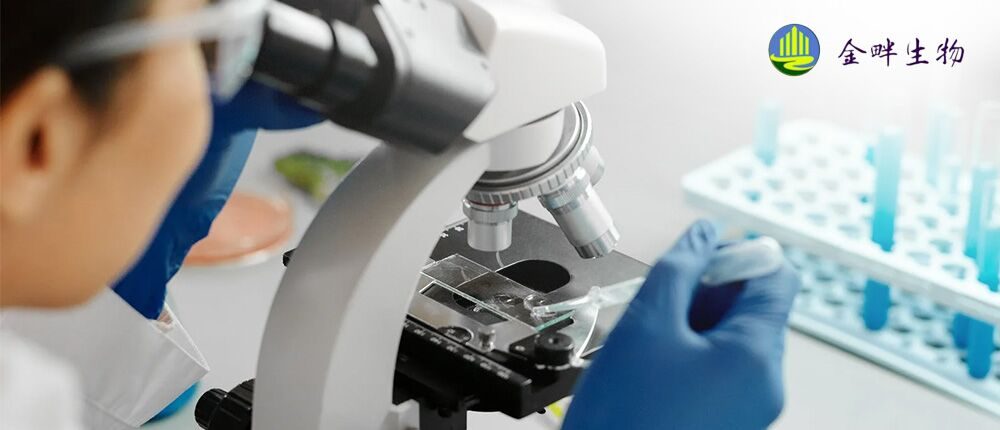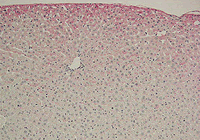| Home > Products > Antibodies > Anti dibromotyrosine antibody |
[ Print page ] |
Rev.081022 |
 |
| Suitable for immunohistocheistry, western blotting and ELISA. For research use only. |
| [ A novel biomarker for protein oxidation ] |
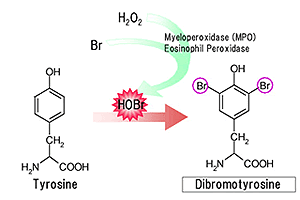 |
Neutrophils and eosinophils play an important role in the defence system against microbial infection. Myeloperoxidase (MPO) and eosinophil peroxidase (EPO) are known to catalyze formation of hypochlorous acid (HOCl) and hypobromous acid (HOBr). These reactive intermediates may react with proteins, lipids and nucleotides, and it has been reported to form tyrosine halogenation such as dibromotyrosine (DiBrY). DiBrY is a Br-modified tyrosine at 3- and 5- position, which is one of the major oxidative products derived from neutrophil myeloperoxidase. |
|
| [ Specific to dihalogenated tyrosine at 3- and 5-position] |
| Monoclonal antibody clone 3A5 have been established by Dr. Toshihiko Osawa (Nagoya Univ.) and Dr. Yoji Kato (Univ. Hyogo). This antibody is specific for 3,5-Dibrominated tyrosine and other di-halogenated tyrosine at 3- and 5- position. Suitable for immunohistochemical analysys of oxidative stress.
|
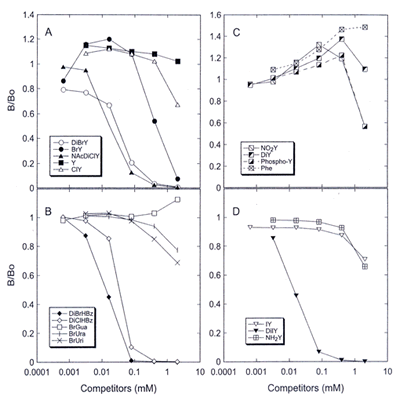 |
|
 |
| [ Oxidative modification of tyrosine ] |
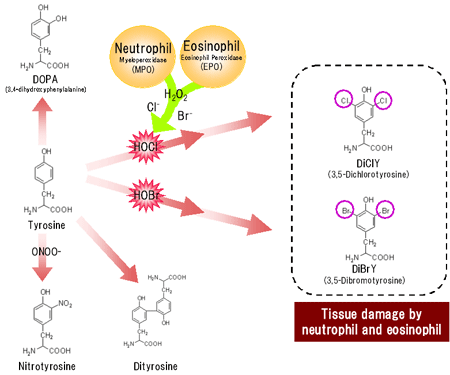 |
Tyrosine is one of the main targets of protein oxidation, and it have been reported form nitrotyrosine, dityrosine and halogenated tyrosines depending on the type of free radicals. For example, hypochlorous acid (HOCl) and hypobromous acid (HOBr) are derived from neutrophil myeloperoxidase (MPO) and eosinophil peroxidase (EPO), and known to form dihalogenated tyrosines such as DiBrY, DiClY and DiIY. It is expected that DiBrY may be a novel biomarker for tissue damage which is related to inflammatory and allergic disorders. |
|
| [ Halogenated tyrosine related diseases ] |
| Cystic fibrosis: |
VD Vliet, et.al.: Myeloperoxidase and protein oxidation in cystic fibrosis. Am J Physiol Lung Cell Mol Physiol. 279, L537-L546 (2000) |
| Atherosclerotic intima: |
Hazen SL: 3-chlorotyrosine, a specific marker of myeloperoxidase ? catalyzed oxidation, is markedly elevated in low density lipoprotein isolated from human atherosclerotic intima.J Clin Invest 99, p2075-2081 (1997) |
| Sepsis: |
Gaut JP, et.al.: Neutrophils employ the myeloperoxidase system to generate antimicrobial brominating and chlorinating oxidants during sepsis. PNAS 98, p11961-11966 (2001) |
| Asthma: |
Wu W, et. al.: Eosinophils generate brominating oxidants in allergen – induced asthma. J Clin Invest 105, p1455-1463 (2000) |
|
 |
| [ Specifications ] |
| Antigen: |
3,5-dibromotyrosine conjugated KLH(keyhole limpet hemocyanin). |
| Form: |
Lyophilized power. Reconstitute by 200 µL of distilled water. 100 µg/mL of IgG. |
| Subclass: |
Mouse IgG1(kappa), clone 3A5. Protein A purified. |
| Specificity: |
This antibody can react with dibromotyrosine (DiBrY), N-acetylated dichloro tyrosine (NAcDiClY), diiodo tyrosine (DiIY), N-bromosuccinimide-treated BSA, HOCl-treated BSA and dibromo-tyrosone conjugated BSA (halogene-modified tyrosine at both 3- and 5-position).
Cross reactivity to following analogues have been tested:
dityrosine-conjugated BSA, peroxynitrite-treated BSA, tyrosine (Y), chrolotyrosine(ClY), 3-3’-dityrosine (DiY), 3-aminotyrosine (NH2Y), 3-nitrotyrosine (NO2Y), phenylalanine (Phe), o-phosphotyrosine, 3,4-dihydroxyphenylacetic acid (DOPA) and 2-hydroxy-4-phenylacetic acid. Weakly react with Bromotyrosine (BrY). |
| Application: |
Immunohistochemistry, western blotting and ELISA. |
| Storage: |
Less than -20°C |
|
 |
| [ References ] |
| 1) |
Y Kato, Y Kawai, H Morinaga, H Kondo, N Dozaki, N Kitamoto and T Osawa.
Immunogenicity of a brominated protein and successive establishment of a monoclonal antibody to dihalogenated tyrosine. Free Rad Biol Med, 38, p24-31 (2005) |
| 2) |
Wu W, Chen Y, d’Avignon A, Hazen SL.
3-Bromotyrosine and 3,5-dibromotyrosine are major products of protein oxidation by eosinophil peroxidase: potential markers for eosinophil-dependent tissue injury in vivo. Biochemistry.38(12):3538-48 (1999) |
|
 |
| Product name |
Code |
Content |
| Anti dibromotyrosine monoclonal antibody |
MBY-020P |
20 µg IgG |
|
|

If you are in the U.S., please click here
to Genox Corporation (Los Angeles, CA).
|
| Instruction manual (PDF) |
Immunohistochemistry |
Technical information |
|
| [NOTICE]: Our products are for RESEARCH USE ONLY. Not for diagnostic, medical or other use.
We are making efforts to prevent errors or mistakes on preparing web site documents, instruction manuals and products.
But even if some damage would be caused by such faults, we will be exempt from responsibility. |
日本衰老控制研究所 Japan Institute For the Control of Aging (JaICA) 专注于衰老研究领域。提供DNA氧化损伤检测试剂盒,并且处于该领域的领先地位。JaICA氧化应激相关产品:DNA氧化损伤检测、脂质氧化检测、蛋白氧化检测、抗氧化分析,以及微量元素分析。详情请咨询JaICA中国区代理商:上海金畔生物科技有限公司。



